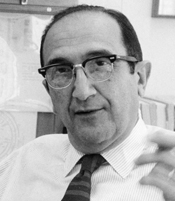Salvador E. Luria, M.D.

Brief Bio
Salvador Edward Luria was born to a Jewish family in Turin, Italy, on August 13, 1912, Luria received his M.D. at the University of Turin in 1935. Drafted into the Italian army, he spent two years as a medical officer in 1936 and 1937 before pursuing postgraduate training in radiology and physics at the University of Rome, where he studied briefly under future Nobel Laureate Enrico Fermi. It was in Rome that Luria first began working with bacteriophage.
In 1938, Luria departed fascist Italy to work at the Radium Institute of Paris. His time at the Curie lab was short-lived, however, for he soon fled Paris by bicycle just ahead of the advancing German army in June of 1940. By September of that year, Luria had made his way to New York, where, with the help of Fermi, who had preceded him to the United States, Luria obtained a Rockefeller Foundation fellowship and became a research assistant at Columbia University College of Physicians and Surgeons. With the support of a Guggenheim fellowship, he spent 1942 working at Vanderbilt University with Delbrück. In 1943, Luria became an instructor at Indiana University, where he remained until 1950, when he accepted a post as professor of microbiology at the University of Illinois. In 1959, following a sabbatical year at the Massachusetts Institute of Technology (MIT), Luria was appointed chair of the newly-formed microbiology department at MIT. Named Sedgwick Professor of Biology in 1964 and founding director of the Center for Cancer Research in 1972, Luria remained at MIT until he retired in 1985, becoming Institute Professor of Biology Emeritus.
Known for his political activism, Luria, in 1953, was denied a passport to deliver a paper at a scientific meeting in Oxford, England. James Watson, Luria's former graduate student at Indiana University, delivered the paper in his absence. Later, Luria publicly opposed U.S. involvement in the Vietnam War, serving as a leader of the highly visible anti-war Boston Area Faculty Group on Public Issues. Within days of winning the Nobel Prize, Luria learned that his name appeared on a National Institutes of Health funding blacklist. The ban, however, was ultimately rescinded or ignored. Luria secured National Cancer Institute funding in 1972 for the MIT Center for Cancer Research.
Luria died of a heart attack in Lexington, Massachusetts, on February 6, 1991, at the age of 78.
Nobel Prize in Physiology or Medicine
1969 Nobel Prize in Physiology or Medicine with Max Delbrück and
Alfred Hershey (AAI '42) “for their discoveries concerning the replication mechanism and the genetic structure of viruses.”
AAI Service History
Joined: 1958
Nobel Prize in Science
Salvador E. Luria was awarded the 1969 Nobel Prize in Physiology or Medicine jointly with Max Delbrück and Alfred Hershey (AAI '42) for "their discoveries concerning the replication mechanism and the genetic structure of viruses." Luria was recognized for his work with Delbrück elucidating the nature of genetic inheritance through pioneering studies with bacteriophage.
Luria addressed the question of whether bacteria develop resistance to viruses called bacteriophage in a process of spontaneous mutation or through an adaptive response to bacteriophage infection, a theory held by many researchers at the time. Soon after accepting a faculty position at Indiana University, he carried out the well-known Luria-Delbrück experiment (or Fluctuation Test), which demonstrated that random mutations arose in bacteria and provided resistance to bacteriophage infection but were not a response to selection. These observations of random genetic fluctuations led Luria to contact his former colleague Max Delbrück, who carried out statistical analyses that supported these findings and led to the publication of this seminal work in 1943.
In 1945, Luria demonstrated that bacteriophage also mutate spontaneously, revealing how they overcome bacterial resistance. As the number of scientists interested in studying bacteriophage grew in the 1940s, Luria, Delbrück, and Hershey became the leading figures of the "phage group," a small, informal network of researchers across the United States studying various aspects of phage. In 1952, working with Indiana graduate student Mary Human, Luria discovered that certain bacteriophage grew well in specific host bacterial strains but grew poorly in other strains. This observation of "restricted" bacteriophage growth was a critical contribution to the late discovery of restriction enzymes. Later in his career, Luria's research interests expanded to include the study of mechanisms by which certain proteins, notably colicin, operate within bacterial cell membranes.
"Luria was both a founder of the new science of molecular biology . . . and one of the most respected intellects in academic science," said Nobel Laureate Philip Sharp. In the 1969 Nobel award announcement, the Karolinska Institute pointed out that Luria's bacteriophage work, along with that of Delbrück and Hershey, "has had a tremendous impact on virology, and has supplied material and techniques which have been essential to the progress of molecular biology."
Awards and Honors
- Member, American Academy of Arts and Sciences, 1959
- Member, National Academy of Sciences, 1960
- Member, American Philosophical Society, 1964
- Lenghi Prize, National Academy of Science (Italy), 1965
- Nobel Prize in Physiology or Medicine, 1969
- Louisa Gross Horwitz Prize, Columbia University, 1969
- Member, Institute of Medicine, 1971
- National Book Award for Life: The Unfinished Experiment, 1974
- National Medal of Science, 1991
Institutional/Biographical Links